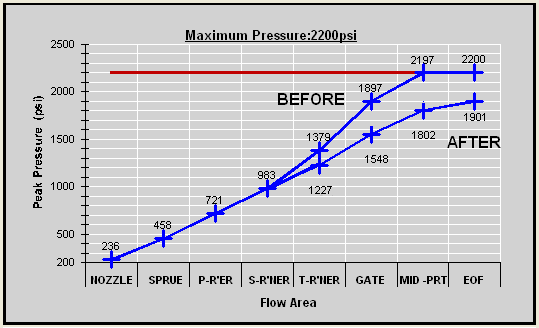By Suhas Kulkarni, FIMMTECH
As plastic flows through the different sections of the injection molding machine and the mold, because of drag and frictional effects there is a loss of the applied pressure at the flow front of the plastic. Additionally, as the plastic hits the walls of the mold, it begins to cool, increasing the viscosity of the plastic requiring additional pressure to push the plastic.
The skin of plastic formed at the walls decreases the cross sectional area of the plastic flow that also results in pressure drop. The injection molding machine has a limited maximum amount of pressure available to push the screw at the set injection speed. The required pressure to push the screw at the set injection speed should never be more than the maximum available pressure. For example, consider that the maximum available hydraulic pressure on an injection molding machine is 2200 psi and the required screw speed is 5 in/sec. In order for the screw to move at 5 in/sec, if it requires 2400 psi, then the machine will not be capable in providing this pressure and the screw cannot move at 5 in/sec. In this case the process becomes pressure limited. During process development, knowing the pressure loss in every section helps in determining the overall pressure loss and the sections where the pressure drops are high. The mold can then be modified to reduce this pressure drop and achieve a better consistent flow. It is important the maximum pressure available is never reached.

In the graph above, during the first mold trail following were observed:
- For the plastic to reach the end of fill, it required all the available pressure of 2200 psi.
- For the plastic to reach the mid section of the part, it required almost all the available pressure of 2200 psi.
- Based on the above two points, the process is pressure limited.
- For the plastic to reach the end of the tertiary runner from the end of the secondary runner, it required 1379-983 = 396 psi.
- For the plastic to go through the gate it required 1897 – 1379 = 518 psi.
Since the tertiary runner and the gate seemed to have a large percentage of pressure drops, the tertiary runner was opened up and the gate was opened up. This lowered the pressure for a final pressure at the end of fill of 1901 psi. Now the process is not pressure limited. Having sufficient injection pressure will now help in reaching the goal of consistent mold filling. Conducting a pressure drop study is one of the important steps during the mold qualification process.
Rules of thumb:
- The maximum required injection pressure should not be more than 80% of the maximum available pressure on the molding machine.
- The above number – 80%, should be lower for thicker parts that need more packing pressure.
- Avoid sudden increases in pressures between sections. The transitions should be as smooth as possible.
Free worksheets for pressure drop studies, other mold qualification graphs and procedures are available at www.InjectionMoldingOnline.com.
About the Author
| Suhas Kulkarni FIMMTECH | Suhas Kulkarni is the President of FIMMTECH, a consulting firm that specializes in services related to injection molding. He earned his Masters in Plastics Engineering from the University of Massachusetts, Lowell and a Bachelors in Polymer Engineering from the University of Poona, India. He has 18 years of experience as a process engineer.His main area of expertise is Scientific Processing for Injection Molding. Based on his experience, he has developed a custom software called Nautilus, that aids the complete process development routine to production release.He also teaches a plastics and molding course at the University of California, San Diego and is a contract faculty at the University of Massachusetts at Lowell.
The company website is www.fimmtech.com and Suhas can be reached at 760-525-9053. Check out Suhas’s Free Global Resource for Injection Mold Processing at Injection Molding Online |
The views, opinions and technical analyses presented here are those of the author or advertiser, and are not necessarily those of ULProspector.com or UL Solutions. The appearance of this content in the UL Prospector Knowledge Center does not constitute an endorsement by UL Solutions or its affiliates.
All content is subject to copyright and may not be reproduced without prior authorization from UL Solutions or the content author.
The content has been made available for informational and educational purposes only. While the editors of this site may verify the accuracy of its content from time to time, we assume no responsibility for errors made by the author, editorial staff or any other contributor.
UL Solutions does not make any representations or warranties with respect to the accuracy, applicability, fitness or completeness of the content. UL Solutions does not warrant the performance, effectiveness or applicability of sites listed or linked to in any content.


